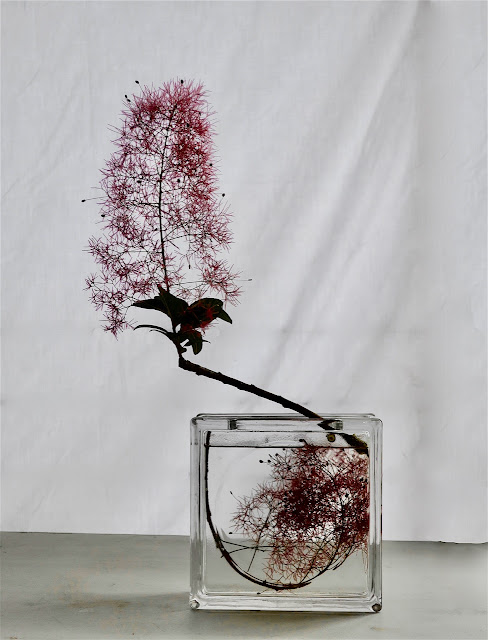In the garden, a week and a half ago, I noticed that the Brachychiton AcerIfolius was looking unhealthy. Some of the leaves were yellowing and dropping. I was worried that it may have had an insect infestation or some other problem.
As I was looking for some explanation I looked up and noticed a small orange-coloured inflorescence that marked the beginning of the tree's first flowering. In some cases these trees will shed all of their leaves at this time of year and be covered in a spectacular display of red flowers.
I am not sure of precisely when we planted this now 4.5 metre tree. But I found a photo taken 32 years ago when it was about 30 cm tall.
It has been a long time coming and we are delighted; even though it is a small flowering. We are fortunate that this tree is tough enough to grow naturally over a wide geographical range from the tropical north of Australia to southern New South Wales. The flowering is especially spectacular because the stems of the panicles are the same bright red as the small bell-shaped flowers. I am hoping that this flowering develops well over the next few weeks.
Two weeks ago the final class for 2024 of my Melbourne class was held in Killingworth near Yea, which is northeast of Melbourne. My student Marcia kindly offered to host our end-of-year event at her property. The theme was "Ikebana at home", with vases provided by Marcia and materials being gathered from the large garden.
The ikebana was arranged on tables on the broad verandah, which created a problem for photography. We needed to hang a sheet as a backdrop, through which the outside light came rather strongly. The result was a degree of silhouetting and an alteration to, and loss of colour.
Jacqueline used a footed vessel in which she arranged a single lichen-covered branch. After trimming the branch she added three stems of Salvia with dark blue flowers.
Marcia used a glass brick in which she set two stems and inflorescences of Smokebush Cotinus corrygria. The submerged stem follows a line in the front surface of the brick. The second stem, which supports a large infloresence, continues this line outside the brick.
Eugenia chose a ceramic vessel made from multiple slightly irregular cylinders. Her materials were branches of Linden Tilia cordata, which was in flower. Placed low at the front is a branch very much covered in lichen.
Aileen chose a "U" shaped square-section vessel in which she set a branch of an unidentified Acacia with interesting irregular lines on the left. On the right side are some purple Clematis flowers set among the seed pods and leaves of the same Acacia. Unfortunately, there is significant colour distortion in the photograph. The Acacia on the right had a distinctly bluish cast which is lost in the photo.
As I was in advance of the students, I had the opportunity to prepare an Omukaebana, 'welcoming arrangement', using a long curving branch of Smokebush. I added a mass of the inflorescence at the mouth of the vessel and underneath the water line. The dark maroon of the smoke bush looked heavy despite its feathery quality, so I added some large pale pink roses to brighten the ikebana.
Greetings from Christopher







No comments:
Post a Comment